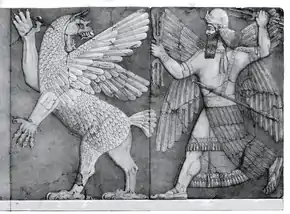Kilili
In ancient Mesopotamian religion, Kilili, ki.li.li; was a female demon of Sumerian origin, likely associated with owls. She is also attested as a minor goddess who functioned as a servant of Ishtar.
| Part of a series on |
| Ancient Mesopotamian religion |
|---|
 Chaos Monster and Sun God |
|
|
Function and Associations
Kilili's name is that of a bird, most likely an owl.[1] In one document she is equated with dab-ba-šú-šú, meaning "she who leans on the window" in Sumerian.[1] She could be called as "queen of the windows", "the one of haunted places" and it assumed she was imagined as an owl-demoness.[2]
She was usually affiliated with Ishtar. Direct identification between them, while attested,[3] is limited to a single late esoteric explanatory text.[4] In the god list An = Anum she is one of Ishtar's eighteen messengers (lúkin-gi-a),[1] alongside other similar figures such as Barīrītu ("she who comes at dusk") and Abtagigi.[5] Kilili under the name dab-ba-šú-šú could be considered as a complement to the goddess Abtagigi, whose name means "retiring through the window."[5] Kilili can be considered as having a connection to sex due to her link with Ishtar, however the "window" in her name is likely not implicating prostitution, unlike for the succubus Kisikil-lila (also called Ardat lilî).[5] The phrase "spilling through the window" can also reference various evils, and Kilili's name has no clear connection to that of Kisikil-lila.[5]
Worship
According to the Tākultu text from the Neo-Assyrian period, she was also worshiped in one of the temples of the goddess Gula,[1] located in Assur.[6] She was also present in neo-Babylonian Uruk, as indicated by a document mentioning offerings of dates to her and a number of pieces of jewelry dedicated to her.[4] She continued to be worshiped there in the Seleucid period.[4] There is also evidence that she was worshipped elsewhere at a temple of Bēlet-Ninua in the neo-Babylonian period.[6]
Possible Depiction in The Burney Relief

The Burney Relief, also known as The Queen of the Night relief, is a terracotta panel from the Old Babylonian Period depicting a nude female figure, standing upon two lions flanked by owls.[7] The goddess possesses wings and birdlike talons, and wears a horned tiara.[7] Several theories as to which deity the relief depicts have been proposed, most commonly Inanna/Ishtar, due to the presence of her symbols (lions), the nudity, and the possible connection between the relief and the myth Inanna's Decent to the Netherworld.[7] Franz Wiggermann, who has done a number of in-depth studies on Mesopotamian demons, asserts that the evidence for the figure as Kilili is the most compelling.[6] The figure on the relief is a goddess, associated with Ishtar (the presence of the lions), has birdlike qualities (linking to Kilili), and contains owls as well, the bird affiliated with her.[6] Unaccounted for are the "loop-ring" symbols held in the hands of the goddess, though this is equally a mystery for any other identification of the goddess.[6]
References
- Lambert 1980, p. 591.
- Wiggermann 2011, p. 315.
- Wiggermann 2007, p. 114.
- Beaulieu 2003, p. 320.
- Wiggermann 2007, p. 112.
- Wiggermann 2007, p. 113.
- Finkel 2021, p. 161.
Works cited
- Lambert, Wilfred G. (1980), "Kilili", Reallexikon der Assyriologie, retrieved 2022-05-17
- Beaulieu, Paul-Alain (2003). The pantheon of Uruk during the neo-Babylonian period. Leiden Boston: Brill STYX. ISBN 978-90-04-13024-1. OCLC 51944564.
- Finkel, Irving L. (2021). The first ghosts : most ancient of legacies. London. ISBN 978-1-5293-0326-1. OCLC 1090201481.
{{cite book}}: CS1 maint: location missing publisher (link) - Wiggermann, Frans (2011-01-01). "The Mesopotamian Pandemonium". SMSR 77/2. Retrieved 2022-05-17.
- Wiggermann, Frans (2007). "Some Demons of Time and their Functions in Mesopotamian Iconography". In Groneberg, Brigitte; Spieckermann, Hermann (eds.). Beihefte zur Zeitschrift für die alttestamentliche Wissenschaft. Berlin, New York: Walter de Gruyter. pp. 102–116. doi:10.1515/9783110204155.1.102. ISBN 978-3-11-019463-0. ISSN 0934-2575.